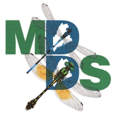Home → Fish & Wildlife → Wildlife → Species Information → Invertebrates → Maine Damselfly and Dragonfly Survey
Maine Damselfly and Dragonfly Survey

Insects in the Order Odonata, damselflies and dragonflies, are a conspicuous component of Maine’s wildlife diversity. Presently, 158 species have been documented in the state, comprising nearly 36% of the total North American fauna. Several of Maine’s odonate species are of national and global conservation concern. Maine currently lists three species as Endangered or Threatened and 25 species as Special Concern. While several odonates are highly sensitive to freshwater habitat degradation, baseline information for the group had been lacking in Maine, until recently.
In 1998, MDIFW initiated the Maine Damselfly and Dragonfly Survey (MDDS), a multi-year, citizen-science atlasing initiative designed to improve our knowledge of the distribution, status, and habitat relationships of damselflies and dragonflies statewide. In addition to accumulating a tremendous amount of scientific data, the MDDS engaged over 200 of Maine’s non-game enthusiasts and raised public awareness of invertebrate conservation generally. Survey’s results exceeded expectations and are best summarized by the following:
Public Outreach and Involvement:
Volunteer participation statewide: → 200
Volunteers trained in MDDS seminars: 95
Major press articles covering the MDDS project: 5
Website hits (http://mdds.umf.maine.edu/): → 20,000
Scientific Contributions:
Total records submitted (% increase over 1999 baseline): 17,264 (229%)
New state species records: 10
New U.S. species records: 2 (Quebec Emerald & Canada Whiteface)
Scientific publications completed or in progress: 5
With the volunteer atlasing component of the MDDS project coming to closure, MDIFW recently contracted Paul M. Brunelle, an odonate expert and graphic design artist from Nova Scotia, to assist with authoring and designing the project’s capstone product: An Atlas and Conservation Assessment of Acadia’s Damselfly and Dragonfly Fauna. Populated largely with data contributed by MDDS volunteers, this atlas will serve as the first authoritative publication on the distribution and natural history of odonates from Maine and the Canadian Maritime Provinces.
This work is supported by volunteer contributions, the State Wildlife Grants program (USFWS), U.S. Environmental Protection Agency, and state revenues from the Loon License Plate, Chickadee Check-off and Maine Outdoor Heritage Fund.